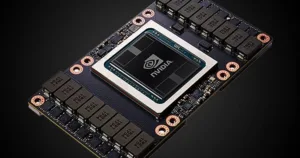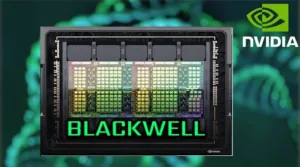When you purchase through links on our site, we may earn an affiliate commission. This doesn’t affect our editorial independence.
Nvidia’s technology is driving the rapid development of artificial intelligence. The company first rose to prominence in the gaming industry. It most sought products today are the high-performance semiconductors that power data centers. This has made Nvidia a significant player in defining the future of artificial intelligence and computers.
Nvidia became a household name because of the production of high-end graphics processing units (GPUs). The company stacks them in thousands inside large server farms. Lately, the company has become so influential, it controls access to one of the most important and scarce commodities in technology; AI and computing power.
From Gaming to AI: Nvidia’s Evolution
Nvidia didn’t start as an AI giant. For years, its GPUs were mostly found in gaming PCs and workstations, helping render ultra-high-quality graphics for video games and professional design. But as AI and computing workloads demanded greater processing power, Nvidia’s chips proved perfect for the job.
Volta: Nvidia’s First Big AI Push
Sometime around 2017, Nvidia launched its first data GPU architecture named Volta. Alongside it came the DGX systems (short for Deep GPU Xceleration). Both are AI supercomputers that made deploying GPUs in data centers much easier.
At the time, DGX was groundbreaking. Now, companies like Dell and Supermicro have followed suit, offering their own GPU-packed servers. But Nvidia was the first to see AI’s potential and build the hardware to support it.

Credit: Nvidia Developers
Ampere: Powering AI’s Next Phase
Nvidia rolled out its Ampere architecture in year 2020 and it still remains in use today. Although newer chips have overtaken it, Ampere was crucial facilitating early AI advancements. The first version of Omniverse, Nvidia’s simulation platform for training robots and digital twins was based on the ampere architecture.
Hopper: The Game Changer in AI and Computing
The chips that actually changed the game for Nvidia happened in 2022 when the company released the Hopper generation of chips. The H100 and H200 GPUs are among the Hopper generation of chips. These chips became the foundation for large language models (LLMs) such as ChatGPT. The H200 was particularly a significant addition. It provided adequate bandwidth and computing power, which is critical as AI models get larger and more sophisticated. The demand for these chips is so huge, it has made it quite hard to find them in stock.
Blackwell: Nvidia’s Latest Powerhouse
Nvidia unveiled Blackwell, its most advanced architecture so far, in year 2024. The company announced the released of Blackwell at the GTC conference. The Blackwell chips are a significant advancement in AI computing power. Though their rollout was marred by some hiccups, major cloud providers are already deploying Blackwell-powered systems.
And Nvidia isn’t slowing down. The company has already hinted about Blackwell Ultra and Rubin, its next-gen architecture set for release in 2026. Plus, for the first time since 2022, Nvidia plans to release a new CPU alongside Rubin, optimizing how tasks are distributed between CPUs and GPUs in AI workloads.

Credit: Techenomy
Nvidia’s Leaps in Software
All this cutting-edge hardware would be useless without the right software. For this reason, Nvidia has prioritized software development and has made giant strides in this field.
CUDA: The Foundation of Nvidia’s AI and Computing Dominance
Back in 2006, Nvidia began developing CUDA (Compute Unified Device Architecture), a software platform that lets developers program GPUs using common coding languages. Without CUDA, only a handful of specialists could harness the full power of these chips.
Today, millions of developers list “CUDA programming” as a skill, and Nvidia’s vast library of CUDA-optimized tools has become a key reason why companies rely on its hardware. Whether it’s medical imaging, weather modeling, or AI training, CUDA makes it all possible.
Nvidia Beyond AI and Computing: Gaming, PCs, and Cars
While AI is now Nvidia’s biggest focus, the company hasn’t abandoned its roots. The company is still pushing boundaries with gaming GPUs. Nvidia’s latest release, the GeForce RTX 5000 series (which includes the RTX 5090 and 5080, both set to be launched in 2025) continues to set the standards for high-end gaming visuals. Even its earlier models like the RTX 4090 and 4080, remain quite popular among gamers and game-makers seeking high performance. Nvidia also works with Apple and ASUS to power high-end PCs with high-end processors. Though gaming is no longer its priority, Nvidia remains a titan in the tech space.
Project DIGITS: AI Supercomputing at Home
For AI enthusiasts who want serious computing power outside a data center, Nvidia introduced Project DIGITS—a compact supercomputer capable of running some of the largest AI models.
Nvidia’s Foray in Automobiles: The Future of Self-Driving Cars
Nvidia is not just about GPUs. The company is also making significant investments in self-driving car. Since 2015, the DRIVE platform, owned by Nvidia has been the preferred platform for companies working on the development of self-driving cars. The company has also entered agreements with Mediatek, Foxconn, Toyota, Uber, and Hyundai over the development of AI-powered driver assistance. It aims to completely change autonomous driving systems. Nvidia is making sure it has a seat at the table. when autonomous-driving becomes mainstream.
The Competition Keeps Growing
Nvidia is undoubtedly the current leader in AI and computing. However, new and strong competitors are also emerging. AMD, Intel, and Huawei are all developing and improving their own AI CPUs. Google, Amazon, and Microsoft are also coming out with their own AI processors to lessen dependency on Nvidia. Nonetheless, with its yet unbearable products rolled out in the markets, Nvidia remains the company to beat.
Nvidia’s Unstoppable Momentum
Nvidia has repeatedly reinvented itself. It started from producing gaming GPUs to producing chips like Blackwell that power breakthrough AI-models. The company shows no signs of slowing down.







